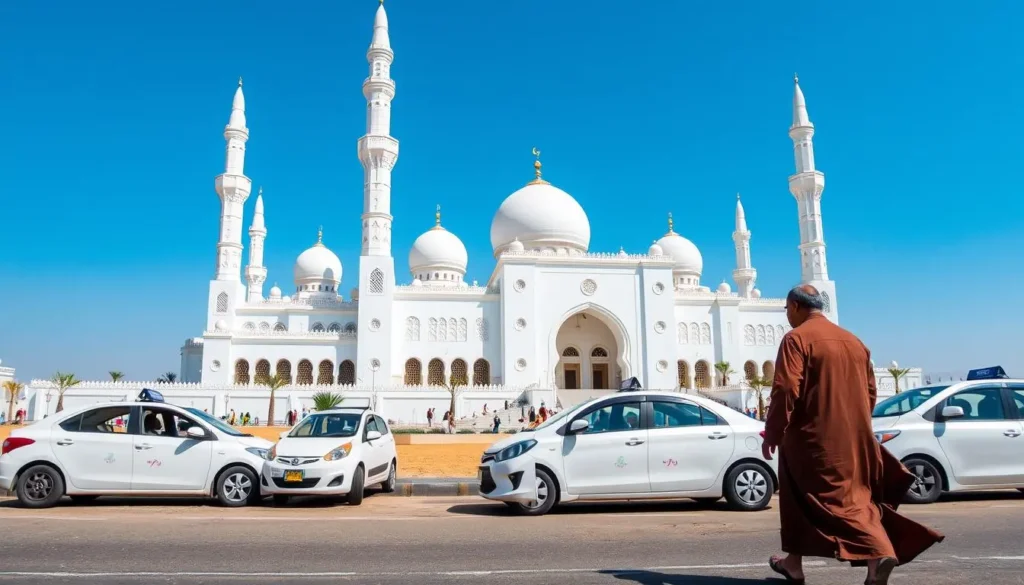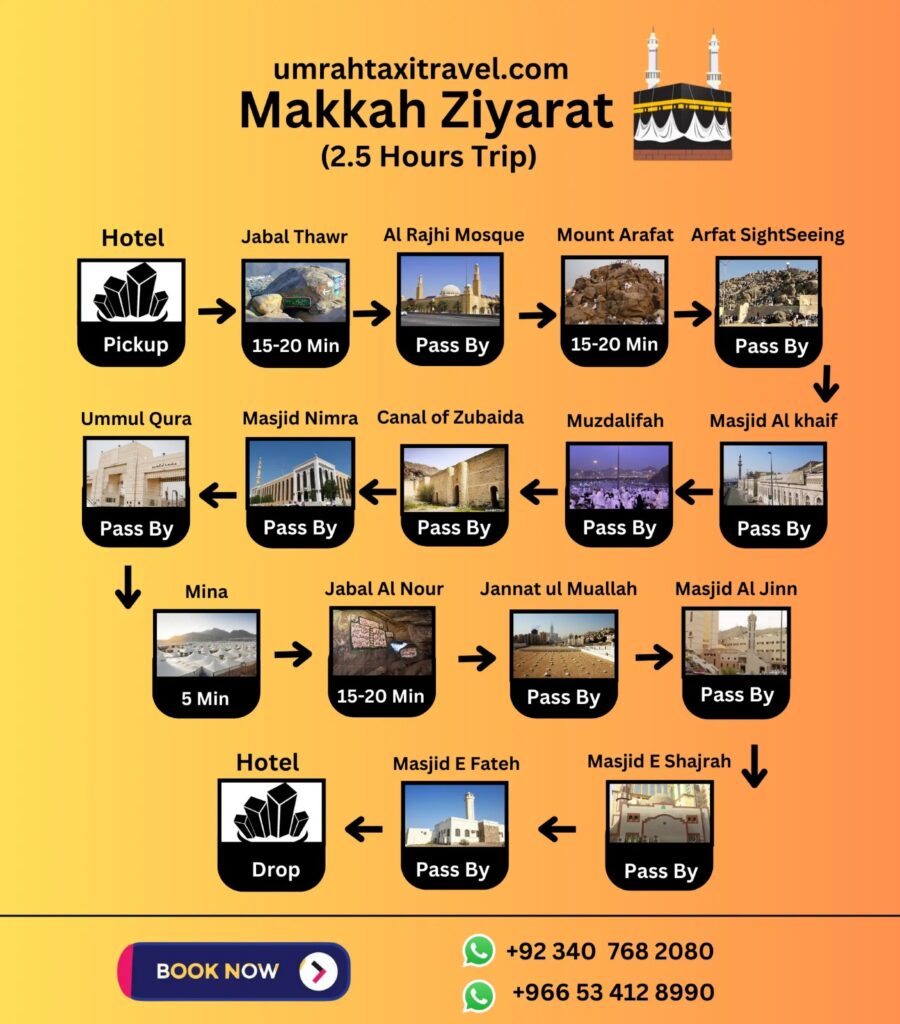Looking for a Makkah Ziyarat taxi? Taxis are the ideal way to explore the holy sites in and around Makkah with ease and comfort. Whether you’re visiting historic landmarks or sacred locations, reliable taxi services make your Ziyarat hassle-free. Discover affordable fares, trusted drivers, and tips for a memorable Makkah Ziyarat experience.

Table of Contents
ToggleMakkah Ziyarat taxi price: All taxi fare
Makkah ziyarat taxi price can vary based on several factors, including the time of day, the type of taxi, and the specific route taken. Here are some approximate estimates:
Camry Car (4 Seats & 3 Luggage): SAR 200
Hyundai H1 (7 Seats & 8 Luggage): SAR 250
GMC XL 2019 (7 Seats & 8 Luggage): SAR 350
GMC XL 2023-24 (7 Seats & 8 Luggage): SAR 450
Hiace (11 Seats & 15 Luggage): SAR 300
Coaster (21 Seats & 25 Luggage): SAR 500

How to Book a Makkah ziyarat taxi
You can easily book a Makkah ziyarat taxi through Our Website Umrah Taxi Travel or by contacting directly via
Whastapp : +966 53 412 8990 or +92 340 768 2080
Don’t wait – contact us today and enjoy a stress-free journey of Makkah Ziyarat Places.

Why you should Choose Umrah Taxi Travel?
Specialized Service: Umrah Taxi Online is tailored for Umrah pilgrims, covering key routes like Makkah to Taif.
Competitive Fares: We provide competitive pricing to fit every budget.
Diverse Fleet: Select from a wide range of vehicles.
Easy Booking: Book your ride with just a few clicks.
Professional Drivers: Our experienced drivers ensure a smooth and informative journey.
24/7 Service: Enjoy hassle-free travel at any time.
Choose Umrah Taxi Online for a stress-free pilgrimage.

Makkah Ziyarat Places Details
Historical and Sacred Places to Visit in Makkah
Makkah is not only the holiest city in Islam but also a land rich in history, miracles, and timeless stories. Beyond the Grand Mosque and Kaaba, several historical and spiritual sites reflect the journey of Prophet Muhammad ﷺ, his Companions, and Islamic history. Below is a detailed guide to some of the most significant places in and around Makkah.
- Jabal Thawr (Mount Thawr)
Located about 7–8 km south of Masjid al-Haram, **Jabal Thawr** holds great importance in Islamic history. It is home to the famous **Cave of Thawr (Ghar-e-Thawr)** where Prophet Muhammad ﷺ and Abu Bakr (RA) took refuge during the migration to Madinah.
Significance: The Qur’an mentions this event when Allah protected them with miraculous means, including a spider’s web and a nesting pigeon at the cave’s entrance, discouraging enemies from entering.
* Today, pilgrims visit this mountain to remember the Hijrah and reflect on faith, patience, and divine protection.
- Al Rajhi Mosque
The **Al Rajhi Mosque**, located in the Aziziyah district of Makkah, is one of the largest and most modern mosques in the city.
Significance: Built by the Al Rajhi family, it is known for its beautiful architecture, spacious prayer areas, and advanced facilities that accommodate large numbers of worshippers, especially during Ramadan and Hajj.
* Many locals and pilgrims stop here for prayers due to its easy accessibility and serene environment.
- Mount Arafat (Jabal Arafat)
Situated around 20 km east of Makkah, **Mount Arafat** is also known as **Jabal al-Rahmah (Mountain of Mercy)**.
Significance: On the 9th of Dhul Hijjah, pilgrims gather here for **Wuquf-e-Arafat**, the central pillar of Hajj. Prophet Muhammad ﷺ delivered his **Farewell Sermon** near this site, emphasizing equality, justice, and brotherhood in Islam.
* Standing at Arafat during Hajj is considered a moment of forgiveness and renewal of faith.
- Masjid Nimra
Located in the plain of Arafat, **Masjid Nimra** is one of the most important mosques associated with Hajj.
Significance: It marks the place where Prophet Muhammad ﷺ delivered his **Khutbat-ul-Wida (Farewell Sermon)** during his last pilgrimage.
* Today, it accommodates thousands of worshippers during Hajj, with special arrangements for Friday and Arafat prayers.
- Canal of Zubaida (Ayn Zubaida)
The **Canal of Zubaida** is a remarkable historical engineering project built by Queen Zubaida, the wife of Abbasid Caliph Harun al-Rashid, in the 8th century.
Significance: Designed to provide fresh water to the people of Makkah and Hajj pilgrims, it stretched from the springs near Taif into Makkah.
* Although parts of it are now in ruins, the canal reflects the commitment of Muslim rulers to serve pilgrims and preserve the sanctity of Hajj.
- Muzdalifah
**Muzdalifah** is a sacred valley between Arafat and Mina, about 9 km from Makkah.
Significance:After leaving Arafat, pilgrims spend the night in Muzdalifah during Hajj. They perform Maghrib and Isha prayers together and collect pebbles that will later be used for the ritual of **Rami al-Jamarat (stoning the devil)** in Mina.
* Muzdalifah symbolizes simplicity, unity, and devotion as millions of Muslims sleep under the open sky.
- Masjid Al Khaif
Nestled in the valley of Mina, **Masjid Al Khaif** is one of the most revered mosques in Makkah.
Significance: Historical narrations suggest that many Prophets prayed here, and Prophet Muhammad ﷺ also offered prayers in this mosque.
* Due to its deep-rooted spiritual importance, Masjid Al Khaif remains a special stop for pilgrims, especially during the Hajj season.
- Mina
Just 5 km east of Masjid al-Haram lies **Mina**, known as the **“City of Tents.”**
Significance: Pilgrims stay here during Hajj to perform the ritual of **Rami al-Jamarat**, symbolizing the rejection of evil by stoning the pillars that represent Shaytan.
* Mina is also the site of the **Animal Sacrifice (Qurbani)** during Eid al-Adha. Today, Mina is filled with thousands of white air-conditioned tents to host millions of pilgrims safely.
- Jabal Al Nour (Mountain of Light)
Located 4 km northeast of the Grand Mosque, **Jabal Al Nour** is famous for housing the **Cave of Hira (Ghar-e-Hira)**.
Significance: It was in this cave that Prophet Muhammad ﷺ received the **first revelation of the Qur’an** through Angel Jibreel (AS).
* The site attracts countless visitors who climb the mountain to witness the place where the journey of Islam began.
- Jannat al-Mu’alla (Mu’alla Cemetery)
Situated near Masjid al-Haram, **Jannat al-Mu’alla** is one of the oldest cemeteries in Islamic history.
Significance: It is the resting place of many close relatives of Prophet Muhammad ﷺ, including his beloved wife **Khadijah (RA)**, grandfather Abdul Muttalib, and other family members.
* Pilgrims visit to pay respects and remember the early sacrifices of the Prophet’s family.
- Masjid al-Jinn
Located close to Jannat al-Mu’alla, **Masjid al-Jinn** is among the most unique mosques in Makkah.
Significance: It marks the spot where a group of jinn gathered to listen to the Qur’an and accepted Islam at the invitation of the Prophet ﷺ.
* This event is mentioned in the Qur’an (Surah al-Jinn), highlighting the universality of the Prophet’s message.
- Masjid al-Shajarah (Mosque of the Tree)
Situated near Masjid al-Jinn, **Masjid al-Shajarah** is a small but historically significant mosque.
Significance: It commemorates the miracle where a tree moved towards Prophet Muhammad ﷺ to testify to his Prophethood.
* Though lesser-known, this mosque reminds believers of the miracles that confirmed the truth of Islam.
 Conclusion
Conclusion
Makkah is a city that holds more than just the Kaaba and Masjid al-Haram. Each of these places — from **Jabal Thawr** and **Jabal al-Nour** to **Masjid Nimra**, **Mina**, and **Jannat al-Mu’alla** — connects pilgrims with powerful stories of faith, sacrifice, and miracles. Visiting these sacred sites allows Muslims to strengthen their spiritual journey and feel closer to the life and mission of Prophet Muhammad ﷺ.


